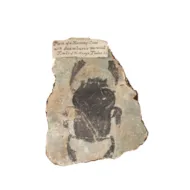Ancient Egyptian Painted Fragment of a Cartonnage Case from a Sarcophagus Depicting a Scarab Beetle
An Ancient Egyptian Painted Fragment of a Cartonnage Case from a Sarcophagus Depicting a Scarab Beetle
Gesso on Linen
Attached old label ‘Piece of a Mummy-Case with Scarabaeus Painted Tombs of the Kings Thebes. J.E.S.’ and another to the reverse ‘Scarabaeus. Tombs of the Kings Thebes. 12th Feb 1867’
3rd Intermediate Period / 22nd Dynasty 945 - 712 BC
Size: 10cm high, 8cm wide, 1.5cm deep - 4 ins high, 3 ins wide, ½ ins deep
Gesso on Linen
Attached old label ‘Piece of a Mummy-Case with Scarabaeus Painted Tombs of the Kings Thebes. J.E.S.’ and another to the reverse ‘Scarabaeus. Tombs of the Kings Thebes. 12th Feb 1867’
3rd Intermediate Period / 22nd Dynasty 945 - 712 BC
Size: 10cm high, 8cm wide, 1.5cm deep - 4 ins high, 3 ins wide, ½ ins deep
An Ancient Egyptian Painted Fragment of a Cartonnage Case from a Sarcophagus Depicting a Scarab Beetle
Gesso on Linen
Attached old label ‘Piece of a Mummy-Case with Scarabaeus Painted Tombs of the Kings Thebes. J.E.S.’ and another to the reverse ‘Scarabaeus. Tombs of the Kings Thebes. 12th Feb 1867’
3rd Intermediate Period / 22nd Dynasty 945 - 712 BC
Size: 10cm high, 8cm wide, 1.5cm deep - 4 ins high, 3 ins wide, ½ ins deep
Gesso on Linen
Attached old label ‘Piece of a Mummy-Case with Scarabaeus Painted Tombs of the Kings Thebes. J.E.S.’ and another to the reverse ‘Scarabaeus. Tombs of the Kings Thebes. 12th Feb 1867’
3rd Intermediate Period / 22nd Dynasty 945 - 712 BC
Size: 10cm high, 8cm wide, 1.5cm deep - 4 ins high, 3 ins wide, ½ ins deep
‘Scarabaeus sacer’ was the sacred scarab beetle of the ancient Egyptians which was personified by the creator god and sun god Khepri associated with resurrection. He is sometimes depicted in tomb paintings and funerary papyri as a man with a scarab as a head, and as a deity closely associated with resurrection. Khepri was also believed to be swallowed by his mother Nut each evening and passed through her body to be reborn each morning.
Because the Egyptians observed that scarab beetles emerged apparently spontaneously from balls of dung, not surprisingly they believed that the scarab was therefore sacred and associated with the process of creation.
Because the Egyptians observed that scarab beetles emerged apparently spontaneously from balls of dung, not surprisingly they believed that the scarab was therefore sacred and associated with the process of creation.
Ex collection of James Ewing Somerville (1843 - 1923) who visited Egypt and Palestine in 1866 - 67 having gained an M.A. in 1862 from Glasgow University
Thence by descent
Thence by descent
Ancient Egyptian Painted Fragment of a Cartonnage Case from a Sarcophagus Depicting a Scarab Beetle

SOLD
















